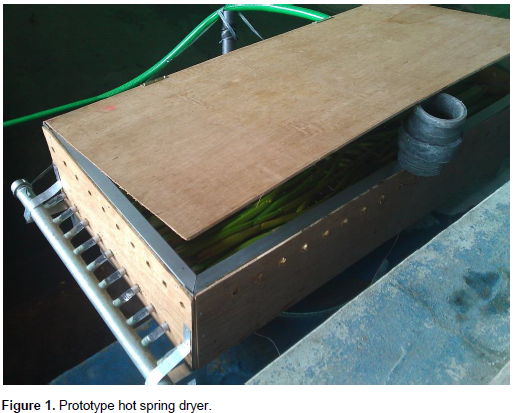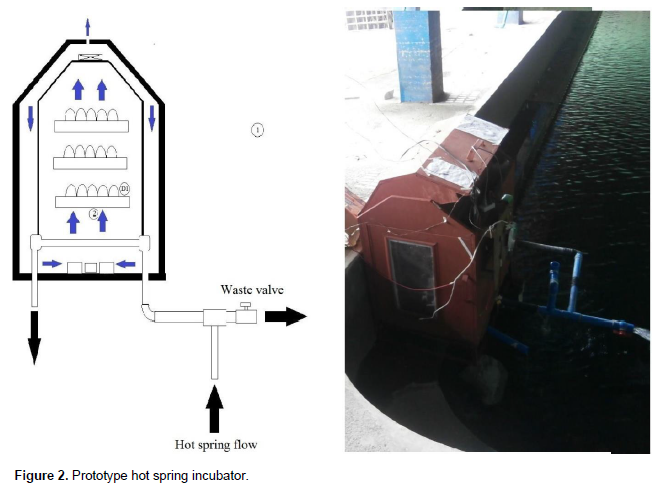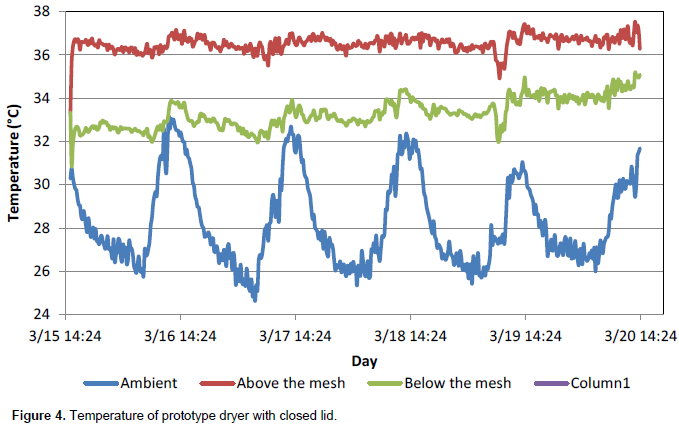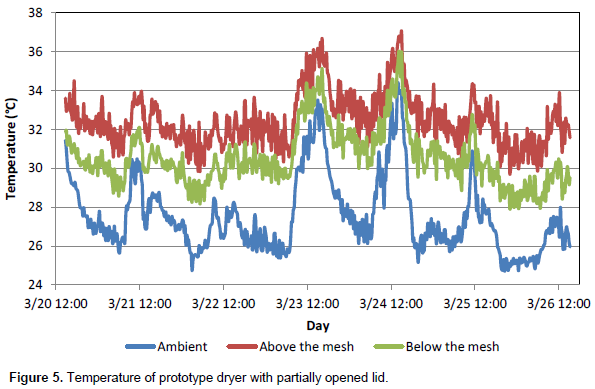ABSTRACT
This is an exploratory research aimed at examining the use of hot spring as a renewable energy source to replace conventional electrical energy for suitable agricultural process in the Los Baňos area, Laguna, Philippines. Here, a potential site was selected by analyzing data of the temperature, relative humidity and hot spring temperature. Preliminary results revealed that average air temperature, relative humidity and hot spring temperature were 26.82°C, 87.48% and 41.49°C respectively. The standard deviation of the hot spring temperature was 0.021°C and analysis revealed that the ambient condition had no effect on the temperature of the hot spring. A prototype water hyacinth dryer was designed from locally available materials using the hot spring as a heat source. The dryer was tested at two settings (closed lid and partially opened lid). Results revealed the average temperature above and below the drying mesh and rate of moisture reduction with closed lid and partially opened lid were 33.30°C, 36.54°C and 16.8 g per hour; 32.47 and 30.56°C and 4.33 g per hour respectively. However, the color of the dried product is unacceptable. The hot spring incubator for balut revealed that average, maximum and minimum temperature was 39.995, 40.5 and 39.38ËšC, respectively at opened setting of 45° waste valve. However, the hot spring incubator can be developed for incubating duck eggs which will reduce the operational cost of balut producers in Los Baňos, Laguna, Philippines.
Key words: Hot spring, water hyacinth, drying, incubating, duck eggs.
Los Banos City is located between the northern part of Mt. Makiling and north shore of Laguna de Bay. It is in Laguna Province, Luzon Island, Philippines. Los Baňos City lacks major commercial core. In 2014, there have been 42 hot spring resorts registered in Los Banos. Because of the hot spring resorts, Los Banos is also recognized as a tourist destination. Most of the hot springs found were located in the barangays (villages) of Lalakay, Tadlac, Bambang and Baybayin. These hot spring resorts are estimated to consume large volume of groundwater which could result to over-extraction and decrease in ground water quantity. However, groundwater is significant for domestic, agricultural, commercial and industrial uses in urban and rural development. Groundwater is often tapped as water supply because of its quality, reducing the costs of treatment compared to surface water sources and its reliability, especially during drought or extended dry periods (Jago-on et al., 2017). Hot spring is considered as geothermal energy freely flowing to the surface. Geothermal energy can be stored as sensible or latent heat.
It is the heat contained in the solid earth and in its internal fluids (Clauser, 1988). Geothermal energy is the energy contained as heat in the Earth's interior (Barbier, 2002); and is well thought-out as a renewable energy and sometimes requires replacement of water in the ground. The temperature of geothermal energy is usually at a constant level which makes it suitable for various applications such as industrial, agricultural and aquaculture process. Table 1 shows some agricultural and aquaculture applications of a hot spring or geothermal heat (Fanchi, 2005). Balut is the fertilized duck egg that has been incubated for a period of 14 to 18 days, then steamed or cooked for about 20 to 30 min. It is common in Asian countries such as Bangladesh, Cambodia, China, Indonesia, Laos, Malaysia, Thailand, and Vietnam. The conventional incubator used for incubation is the electrical incubator. In the Philippines, duck egg production sites are usually located near rivers and lakes. In the province of Laguna, large scale duck egg production is located in the municipalities of Los Baños and Victoria due to its proximity to the Laguna de Bay (Atienza el al., 2015).

Another emergent industry in Los Baňos is the manufacturing process of these handicrafts which involves drying of water hyacinth before weaving. Conventional drying of the Water hyacinth is usually accomplished by spreading the water hyacinth on the concrete pavement. The process takes at least two weeks of favorable weather condition which may extend up to four weeks depending on the weather. Water hyacinth (Eichhornia crassipes) forms dense mats that interfere with navigation, recreation, irrigation, and power generation (Rajamohan, 2009). For this reason, it has become one of the major problems in Laguna Lake and has been blamed for the flooding in Metro Manila and other nearby provinces (Abon et al., 2012). The emergence of hot springs at near volcano areas has provided an alternative option for system with low-energy input for drying or incubating. Since Los Baňos is among the three large producers of duck eggs in Laguna, emergent of weaving water hyacinth and recognized for the availability of hot spring, it is deemed necessary to explore an alternative means of utilizing the hot spring for agricultural processes using the hot spring as heat source for drying or incubation. This study focuses on the exploration of alternative use of hot spring for agricultural processes instead of using hot spring for resorts which are high consumers of water.
Selection of test site
The test site located at Barangay Malinta, Los Baños with coordinates 14° 10’ 55.91” N and 121° 13’ 36.49” E was selected as it features a hot spring, a source of renewable energy which is not optimized for any productive purpose, aside from being in a shaded area or a pool of unused and abandon hot spring.
Initial data gathering
Fresh stalks of water hyacinth were collected for determination of moisture content; thereafter, the stalks were cut into three sections: bottom; middle; and top. The sections of each stalk were mixed and bound prior to weighing. The total weight of the samples was obtained using triple beam balance, while the moisture content (dry basis) of the samples was obtained using oven dry method by drying the samples for 48 h. The final weight of the bone dried samples determined the amount of moisture that the samples contain. Stalks that were dried to an industry-acceptable level were obtained. The dried stalks were cut into three sections: bottom; middle; and top. The sections of each stalk were mixed and bound prior to weighing. The total weight of the samples was obtained using triple beam balance, while the optimum moisture content (dry basis) of the samples was obtained using oven dry method by drying the samples for 48 h at 105ËšC.
Design and fabrication the prototypes
Two prototypes were fabricated to evaluate the utilization of hot spring for agricultural processes (drying and incubating). The heat loads were calculated using principles of thermodynamics and heat transfer. All materials use to fabricate were locally available materials. The dimension of the dryer was 1.0 m × 0.5 m × 0.1 m while the capacity of the hot spring incubator was 165 duck eggs.
Testing procedure
The purpose of this fabrication was to explore the utilization of the hot spring for appropriate agricultural process which includes the two processes: water hyacinth drying and incubation of duck eggs for balut. The testing of the dryer hot spring dryer (Figure 1) consisted of two cycles of 48 h run with the dryer fully loaded. The test consisted of a single factor (lid setting) at two levels (lid fully closed and lid partially opened). The temperature data collected during the test were at a point above the mesh, below the mesh and the hot spring. The weight of the water hyacinth was also at the beginning and end of each run. The no load test was also conducted to explore the use of the hot spring incubator for balut production (Figure 2) which is a major industry in Los Baňos City. The significance of the no load test was to observe the temperature in the hot spring incubator which was closed with three equal evaporating pans while varying the supply of hot spring in the incubator using the waste valve to monitor the temperature. The temperature was recorded every hour by averaging hundred samples per hour, taking the reading of the atmospheric temperature, the temperature at the bottom and top tray in the hot spring incubator. Temperature data were collected over the period of three consecutive days. Descriptive statistical analysis was use to analyze the means, maximum and minimum of the temperature, rate of drying and moisture content.


Ambient conditions
Results of the initial data gathering showed that the average dry bulb temperature was 26.82°C. In addition, the average wet bulb temperature was found to be 25.13°C. By plotting the dry and wet bulb temperature on the psychometric chart the relative humidity (RH) was obtained. The average relative humidity was 87.48% with a maximum of 92.92% and a minimum of 74.19% RH were collected respectively (Figure 3). These values showed a rhythmic variation wherein the maximum relative humidity occurs during the early hours in the morning and the minimum occurring at noon time. Figure 3 also indicated that the water temperature had a small variation throughout the duration of the preliminary data gathering. The average temperature of water was noted to be at 41.49°C with a very small standard deviation of 0.021°C which also indicated that the ambient condition does not affect the temperature of water from the hot spring.

Fresh and optimal drying moisture content of water hyacinth
From an initial weight of 460.46 g, the moisture content of a fresh water hyacinth sample was found to be at 93.46% wet basis and 1,429.77% dry basis. The optimum moisture content of the water hyacinth based on industry acceptable level for handicraft production was 16.58% wet basis and 19.87% dry basis from an initial weight of 9.23 g. This shows that a lot of water needs to be removed from the fresh stalks for it to be useful.
Evaluation of prototype dryer with closed lid
As shown in Figure 4, a decrease in the temperature reading at the reference point below the mesh was noted. This may be attributed to opening of the lid during loading of samples. An average difference of 3.24°C was observed during the test which is more than three times that of the dryer without samples. The average temperature at the reference point below the mesh had an average of 33.30°C while the reference point above the mesh had an average of 36.54°C. The temperature readings above the mesh were notably consistent. Only the readings below the mesh expressed a noticeable drop which may be attributed to the cooling effect of the fresh samples loaded into the dryer. Furthermore, it was also observed that the diurnal temperature readings of the ambient condition did not affect the temperature readings inside the dryer. From an initial weight of three kilograms, the weight of the samples inside the dryer was reduced to 985 g.

The percent of moisture removed from the samples was computed to be 67.1% after running the prototype dryer for five days. The rate of moisture reduction was computed to be 16.8 g per hour. On the other hand, the samples placed outside the dryer (control) with an initial weight of three kilograms was reduced to 800 g. The control had a percent moisture reduction of 73.3%, with a rate of moisture reduction of 18.3 g per hour. Comparing the percent and rate of moisture reduction of the control and the samples inside the dryer, it was noted that the dryer had a lower drying performance which may be attributed to the lower air flow inside the dryer which is aggravated by the closed lid scenario. The dryer was designed to increase air flow rate by introducing a temperature gradient; however, the air flow was actually impeded. This may also be due to the lack of air vents in the upper portion of the dryer.
Evaluation of prototype dryer with partially opened lid
Figure 5 shows that the temperature profile of the dryer decreased when the lid was partially opened. The temperatures approached near the ambient temperature, indicating that the ambient condition had an effect on the temperature readings inside the dryer to the point of having a diurnal trend. The average difference between the temperature readings at the two reference points (below and above the mesh) was 1.91°C. This difference was lower compared with that of closed lid setup which may be attributed to the increase in air flow rate inside the dryer. From an initial weight of 985 g, the weight of the samples inside the dryer was reduced to 210 g after 10 days of running the setup. The percent of moisture removed from the samples was computed to be 78.7%. The rate of moisture reduction was computed to be 6.46 g per hour. On the other hand, the samples placed outside the dryer (control) with an initial weight of 800 g was reduced to 280 g. The control had a percent moisture reduction of 65%, with a rate of moisture reduction of 4.33 g per hour.

For a three kilogram fresh sample, the desired final weight should be 235 g based on the previously determined values of moisture content for fresh and optimum moisture content. The final weight of samples from the prototype dryer (210 g) was comparable with that of the desired final weight. However, the color of the product is not yet visually acceptable since some sections of the stalks are still green (Figure 6). Comparing the percent and rate of moisture reduction of the control and the samples inside the dryer, it was noted that the dryer had a better drying performance. This may be attributed to the increased air flow inside the dryer brought by the heat exchanger which introduced larger temperature gradient to the system. Results of the experiment showed that the partially opened setup was observed to perform better than the closed lid setup. The air flow inside the dryer was increased with the opening of the lid, which also increases the drying rate.

Evaluation of the hot spring incubator
The hot spring incubator for duck eggs was tested with no load and opening the waste valve for the hot spring flow at three different levels. The temperature and relative humidity (RH) were evaluated over the period of 24 h per run with the experiment consisting of five runs. The results from the experiment revealed that the average, maximum and minimum temperature for the three settings (waste valve fully closed, 45° opened waste valve and fully opened waste valve were 40.161, 41 and 37.5°C; 39.995, 40.5 and 39.38°C; and 38.919, 40.7 and 36.5°C, respectively as shown in Table 2. In passerine birds, embryos develop optimally between 36 and 40°C, temperatures above 40.5°C is lethal, and development is suspended below 24 to 26°C (that is, physiological zero (Arnold et al., 1987; Webb, 1987; Stoleson and Beissinger, 1995; Cooper et al., 2005). Further study by Taplah et al. (2013) revealed that the hatchability (percentage of duck eggs successfully hatch) and balutability (percentage of duck eggs successfully incubated for 14 to 18 days) were 62.5 and 99.31% respectively.


The possibility of integrating a solar collector could also improve the system by introducing additional heat input. This could cause an increased temperature gradient through the utilization of another renewable energy source. Further study which includes effects of ambient conditions that could enhance fungal activities and the effect of drying on color is recommended since it is not covered by this study. Majority of the ducks grown in the Philippines are the Mallard and about 90% of the eggs produced are used to process balut (Chang and Villanoz, 2008). Deep body temperatures for the domestic duck were 41.5 to 42.5°C (King and Farner, 1961) while deep body temperatures for Mallard were about 41°C (Caldwell and Cornwell, 1975). Duck egg air cell temperatures reached 41.5°C several times during the study, probably because the probed portion of the egg was in close contact with the brood patch and perhaps because of embryonic activity and heat production. Egg air cell temperature averaged 36.3°C (Caldwell, 1971). However, the hot spring temperature matched the deep body temperature and the maximum duck egg air cell temperature of 41.5°C. Further study can be conducted to optimize the hot spring incubator for duck eggs which will reduce the operational cost of balut production in Los Baňos, Laguna, Philippines.
The authors have not declared any conflict of interests.
REFERENCES
|
Abon CC, Carlos P, David C, Guillermo QT III (2012). Community-based monitoring for flood early warning system: An example in central Bicol River basin, Philippines. Disaster Prev. Manag. Int. J. 21(1):85-96.
Crossref
|
|
|
|
Arnold TW, Rohwer FC, Armstrong T (1987). Egg viability, nest predation, and the adaptive significance of clutch size in Prairie Ducks. Am. Nat. 130:643-653.
Crossref
|
|
|
|
|
Atienza M, Rodriguez DP, Babilonia MG, Guimary M, Rebancos C (2015). Food safety study of duck eggs produced along Laguna Lake areas, Philippines. J. Nutr. Food Sci. S3:005.
|
|
|
|
|
Barbier E (2002). Geothermal energy technology and current status: an overview. Renew. Sustain. Energy Rev. 6(1-2):3-65.
Crossref
|
|
|
|
|
Caldwell PJ (1971). Nest microclimate and nesting behavior in the Mallard (Anas platyrhynchos) at Delta, Manitoba. Unpublished M.S. thesis, Gainesville, Univ. Florida.
|
|
|
|
|
Caldwell PJ, Cornwell GW (1975). Incubation behavior and temperature of the Mallard duck. American Ornithological Society. 28-08-2017 14:08 UTC. The Auk. 92(4):706-731.
Crossref
|
|
|
|
|
Chang HSC, Villanoz R (2008). Production in the Philippines: A Productivity Analysis. Int. J. Poult. Sci. 7(10):940-948.
Crossref
|
|
|
|
|
Clauser C (1988). Handbook of Terrestrial Heat Flow Density Determination. Dordrecht: Kluwer Academic Publishers. pp. 143-165.
|
|
|
|
|
Cooper CB, Hochachka WM, Butcher G, Dhondt AA (2005). Season and latitudinal trends in clutch size: thermal constraints during laying and incubation. Ecology 86:2018-2031.
Crossref
|
|
|
|
|
Fanchi JR (2005). Energy in the 21th Century. Hackensack, NJ: World Scientific.
Crossref
|
|
|
|
|
Jago-on KAB, Siringan FP, Balangue-Tarriela R, Taniguchi M, Reyes YK, Lloren R, Peňa MA, Bagalihog B (2017). Hot spring resort development in Laguna Province, Philippines: Challenges in water use regulation. J. Hydrol. Reg. Stud. 11:96-106.
Crossref
|
|
|
|
|
King JR, Farners DS (1961). Energy metabolism, thermoregulation and body temperature. in Biology and comparative physiology of birds, vol. 2 (A. J. Marshall, Ed.). New York, Academic Press. pp. 215-288.
Crossref
|
|
|
|
|
Rajamohan N (2009). Equilibrium studies on sorption of an anionic dye onto acid activated water hyacinth roots. Department of Chemical Engineering, Faculty of Engineering, Sohar University, Sohar, Sultanate of Oman. Afr. J. Environ. Sci. Technol. 3(11):399-404.
|
|
|
|
|
Stoleson SH, Beissinger SR (1995). Hatching asynchrony and the onset of incubation in birds, revisited. When is the critical period? Curr. Ornithol. 12:191-270.
Crossref
|
|
|
|
|
Taplah AJ Jr, Suministrado DC, Amongo RMC, Paras FO Jr, Elauria JC (2013). Development of hot spring water fed incubator for duck eggs. College of Engineering and Agro-industrial Technology. University of the Philippines- Graduate School. (Unpublished Thesis).
|
|
|
|
|
Webb DR (1987). Thermal tolerance of avian embryos: A review. The Condor 89:874-898.
Crossref
|
|